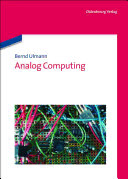
Preview Analog Computing
Analog Computing von Prof. Dr. Bernd Ulmann Oldenbourg Verlag München Dr. Bernd Ulmann is a professor for business informatics at the FOM in Frank- furt/Main, Germany. His main area of interest is that of analog computing. He not only collects and restores old analog computers, but also works actively on future applications of analog computing for high performance computing and low power applications. Bibliografische Information der Deutschen Nationalbibliothek Die Deutsche Nationalbibliothek verzeichnet diese Publikation in der Deutschen Nationalbibliografie; detaillierte bibliografische Daten sind im Internet über http://dnb.d-nb.de abrufbar. © 2013 Oldenbourg Wissenschaftsverlag GmbH Rosenheimer Straße 143, D-81671 München Telefon: (089) 45051-0 www.oldenbourg-verlag.de Das Werk einschließlich aller Abbildungen ist urheberrechtlich geschützt. Jede Verwertung außerhalb der Grenzen des Urheberrechtsgesetzes ist ohne Zustimmung des Verlages unzulässig und strafbar. Das gilt insbesondere für Vervielfältigungen, Übersetzungen, Mikroverfilmungen und die Einspeicherung und Bearbeitung in elektronischen Systemen. Lektorat: Dr. Gerhard Pappert Herstellung: Tina Bonertz Titelbild: Autor Einbandgestaltung: hauser lacour Gesamtherstellung: Beltz Bad Langensalza GmbH, Bad Langensalza Dieses Papier ist alterungsbeständig nach DIN/ISO 9706. ISBN 978-3-486-72897-2 eISBN 978-3-486-75518-3 TomybelovedwifeRikka. Acknowledgments Thisbookwouldnothavebeenpossiblewithoutthesupportandhelpofmanypeople. First of all, I would like to thank my wife Rikka Mitsam who not only did a lot of proofreading and a terrific job in preparing many of the pen-and-ink drawings but alsonevercomplainedaboutbeingneglectedalthoughIlivedthelastmonthsmoreor lessinseclusionwritingthisbook. I am particularly grateful for the support and help of Jens Breitenbach who did a magnificent job at proof reading and provided many suggestions and improvements enhancing the text significantly. He also suggested to use the Kp-fonts and spotted manyLATEX-sinsofminethusimprovingtheoverallappearanceofthisbookconsider- ably. Inadditiontothat,IwouldliketothankBenjaminBarnickel,ArneCharlet,Daniela Koch, Theresa Szczepanski and Dr. Reinhard Steffens for their invaluable help in proofreading. Additionally,IwouldliketothankToreSindingBekkedalwhotookthepictureshown in figure 8.32, Tim Robinson who built the incredible Meccano-Differential Analyzer shown in figure 2.19, Tibor Florestan Pluto who took the photo shown on the title page, Robert Limes who took the picture shown in figure 9.3, and Bruce Baker who donatedthepicturesshowninfigures11.41,11.43,and11.44fortheirpermissionsto usetheaforementionedpictures. WithoutthecontinuousencouragementofDr.habil.KarlSchlagenhaufandhisin- valuablesuggestionsthisbookmightverywellnotexistatall. Last but not least, I would like to thank Prof. Dr. Wolfgang Giloi, Prof. Dr. Rudolf Lauber,Dr.AdolfKley,andProf.Dr.GünterMeyer-Brötzforsharingtheirmemo- riesoftheearlydaysofanalogcomputingatTelefunkenetc. ThisbookwastypesetwithLATEX,usingKp-Fonts;mostschematicsweredrawnusing EAGLE and Arno Jacob’s wonderful analog computing symbol library, other vector graphicswerecreatedwithxfig. Registered names, trademarks, designations etc. used in this book, even when not specificallymarkedassuch,arenottobeconsideredunprotectedbylaw. Contents 1 Introduction 1 1.1 Outline................................................................... 1 1.2 Thenotionofanalogcomputing ......................................... 2 1.3 Directandindirectanalogies ............................................ 3 2 Mechanicalanalogcomputers 5 2.1 Astrolabes................................................................ 5 2.2 TheAntikytheramechanism............................................. 5 2.3 Sliderules................................................................ 6 2.4 Planimeters .............................................................. 8 2.5 Mechanicalcomputingelements......................................... 11 2.5.1 Functiongeneration...................................................... 12 2.5.2 Differentialgears......................................................... 14 2.5.3 Integrators ............................................................... 14 2.5.4 Multipliers............................................................... 17 2.6 Harmonicsynthesizersandanalyzers.................................... 18 2.7 Mechanicalfirecontrolsystems.......................................... 21 2.8 Differentialanalyzers .................................................... 23 3 Thefirstelectronicanalogcomputers 31 3.1 HelmutHoelzer ........................................................ 31 3.1.1 The“Mischgerät” ........................................................ 32 3.1.2 Hoelzer’sanalogcomputer.............................................. 38 3.2 GeorgeA.Philbrick’sPolyphemus...................................... 44 3.3 Electronicfirecontrolsystems ........................................... 47 3.4 MIT ...................................................................... 53 4 Basiccomputingelements 55 4.1 Operationalamplifiers................................................... 55 4.1.1 Earlyoperationalamplifiers ............................................. 59 X Contents 4.1.2 Driftstabilization........................................................ 61 4.2 Summers................................................................. 64 4.3 Integrators ............................................................... 67 4.4 Coefficientpotentiometers............................................... 70 4.5 Functiongenerators...................................................... 73 4.5.1 Servofunctiongenerators................................................ 74 4.5.2 Curvefollowers .......................................................... 75 4.5.3 Photoformers ............................................................ 76 4.5.4 Varistorfunctiongenerators ............................................. 76 4.5.5 Diodefunctiongenerators ............................................... 77 4.5.6 Inversefunctions......................................................... 79 4.5.7 Functionsoftwovariables ............................................... 79 4.6 Multiplication............................................................ 80 4.6.1 Servomultipliers......................................................... 80 4.6.2 Crossed-fieldselectron-beammultiplier ................................. 80 4.6.3 Hyperbolicfieldmultiplier .............................................. 81 4.6.4 Timedivisionmultipliers ................................................ 83 4.6.5 Logarithmicmultipliers.................................................. 83 4.6.6 Quartersquaremultipliers............................................... 84 4.6.7 Othermultiplicationschemes............................................ 85 4.7 Divisionandsquareroot................................................. 85 4.8 Comparators............................................................. 85 4.9 Limiters.................................................................. 87 4.10 Resolvers................................................................. 87 4.11 Timedelay............................................................... 88 4.12 Randomnoisegenerators ................................................ 90 4.13 Outputdevices........................................................... 90 5 Analogcomputeranatomy 93 5.1 Analogpatchpanel ...................................................... 93 5.2 Functiongenerators...................................................... 95 5.3 Digitalpatchpanelandcontrols......................................... 96 5.4 Readout.................................................................. 97 5.5 Control .................................................................. 98 5.6 Performingacomputation ...............................................100
